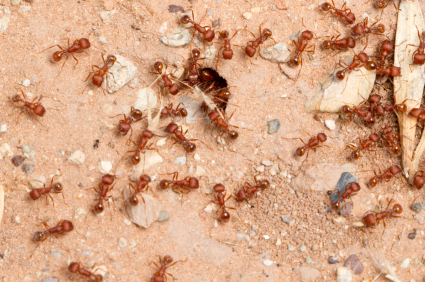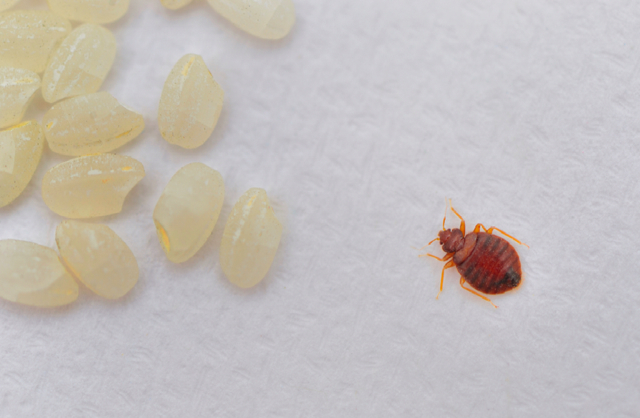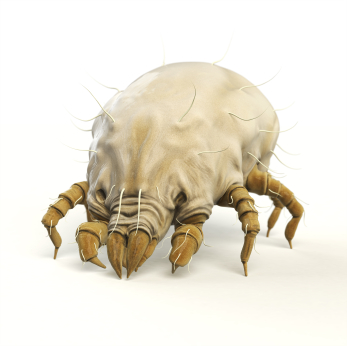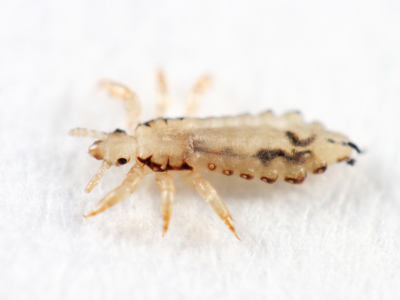Bugs! Kids Guide to Pests!
Did you realize that there are over 12,000 different species of ants throughout the world? Did you know that ants can lift up to 20 times their own body weight? Ants are just one type of pest that most people are familiar with yet really don’t know much about. What do bugs eat and how do they impact humans or the environment? The purpose of this guide is to provide basic information on a variety of common pests and give you tips on how to prevent them. Each pest is followed by some links with more information on the particular bug, and pest activity and experiment links are at the end of the guide.
Ants
Did you know that there is a type of ant that is more aggressive than other ant species and can give you a painful sting? The red imported fire ant can also adapt to different conditions and climates in and near where they live. If they sense there is too much water in their nest they will form into a big ball that can float on water. Ant bodies have three segments and are oval in shape. They have six legs, an antenna and range in size from about one-sixteenth to five-eighth of an inch. Queen and male ants have wings while worker ants do not. Ants can be different earth tone colors of brown, black and red.

The common names (such as carpenter ant and pavement ant) and species (such as solenopsis invicta for the red imported fire ant) of ant vary, but all ants are part of the same order (hymenoptera), family (formicidae), kingdom (animalia), phylum (arthropoda) and class (insecta). Ant diets vary according to specific type of ant, but can include: sweet or sugary substances; meats; eggs; fats; oils; grease; dead and living insects; plant nectar; honeydew; vegetation; nuts; seeds; bread; and cheese. Ants need both proteins and carbohydrates. Ants are social insects who live in colonies. Most ants live in soil or pockets they create in plants. They often like wet areas that are near a food source. Some ants will nest in walls or floor cracks in your home.
How do ants impact your life? They are not usually health threatening, but can contaminate food by leaving their waste behind. People who are allergic to insect stings can have a severe reaction to the sting of the fire ant and it is painful. In addition, the mounds that fire ants build in soil can damage plant roots and cause crop loss. Carpenter ants can dig tunnels in wood in your home and can potentially damage the wood that keeps your home standing.
Bed Bugs

Have Bed Bug Problems?
Did you know that bed bugs feed on warm-blooded animals? They are often found in beds which is how they got their name. They can also be found on airplanes or couches. Bed bugs are flat, oval-shaped pests that are approximately one-quarter to three-eighths of an inch long. They are wingless with six legs and have antenna. They are brown in color until they suck blood and change to red. Their species name is cimex lectularius. Their other scientific information includes: kingdom (animalia); phylum (arthropoda); class (insecta); order (hemiptera); and family (cimicidae). All warm-blooded animals are their diet, but humans have the most exposed skin to bite. They do not spread disease, but inject skin with their saliva which can cause red and itchy welts.
Bees/Wasps
There are over 20,000 different species of bees, and 4,000 different kinds of wasps. Bees live in colonies, and only the female bees actually sting. Wasps can be very aggressive and can often sting multiple times. They tend to be more active during the day.
Bees are typically oval shaped and one-half to one inch in length. They all have wings, antenna and six legs but vary slightly in their coloring. For example, carpenter bees are blue to black in color while bumble bees are the more familiar black with yellow stripes. Common names and species vary for bees, but they are all of the same: kingdom (animalia); phylum (arthropoda); class (insecta); order (hymenoptera); and family (apidae). For most bee types the worker bees collect nectar and pollen from flowers and use it to feed larvae and other colony members. Honeybees actually produce honey from the nectar and pollen of the plants they choose to pollinate. They store the honey in honeycombs made of wax which are located in their nests. The honeycombs are used to feed the young of the honeybees when the weather is colder. Bumble bees usually nest in the ground but can also be found around decks and patios which are above ground. Their nests can also be found sometimes in attics or under roof beams. Honeybees have manufactured hives in tree crevices or nests in attics or chimneys.

Bees are beneficial because they make honey and pollinate plants and crops. Bees can sting you which can be painful with swelling and irritation that can last for one or more days. The problem with killer bees is not the pain of one sting but the fact that they tend to attack in larger numbers. Carpenter bees can damage wood where they decide to build their nests. The best prevention tip is to call a pest management expert or a beekeeper if you have bee problems. They know just how to get rid of these pests.
Wasps range in size from approximately three-eighths of an inch to one and one-half inches in length. All wasps have six legs, antenna and wings. They tend to be black and yellow or white in color. Their common names (such as european hornet) and species names (such as vespa crabro) differ, but all wasps have the same: kingdom (animalia); phylum (arthropoda); class (insecta); order (hymenoptera); and family (vespidae).

The diet of wasps varies a little according to type, but most eat at least one of these types of food: nectar, fruit juices, large insects such as grasshoppers or flies, spiders, meat and sweets. Some wasps such as the bald-faced hornet build large nests hanging from trees, vegetation, buildings and bushes. The european hornet builds their nests in hollow trees, sheds, barns, attics and hollow areas of walls in homes. The yellow jackets build their nests underground. They like dark, cool places and to be near garbage. They also build nests in shrubs, trees and holes in walls. Some wasps are actually beneficial such as the yellow jacket who eats pests that can destroy farmer’s crops. Wasps tend to be able to sting multiple times and the stings usually itch, swell and hurt for approximately 24 hours. Humans can have allergic reactions to the stings which are more severe. Make sure to not leave your sugar drinks out where wasps may be able to get to.
Dust Mites
Did you know that an average mattress can have tens of thousands of dust mites on it? One square yard of carpet can have almost 100,000 dust mites living in it? These little pests are only about one-seventififth of an inch in length and have eight legs. They are wide, flat and oval in shape and do not have wings nor antenna. They are off-white to tan in color. Their scientific information includes: kingdom (animalia); phylum (arthropoda); class (arachnida); order (acariformes); family (pyroglyphidae); and species (dermatophagoides farinae).

Dust mites eat dead skin which is shed by both humans and a variety of other animals. They are also able to absorb moisture from the air. Most bed bugs are found in beds yet they can also be living in furniture, clothing or carpeting. Though dust mites are typically not a problem for most people, they do carry allergens which can cause some people to have an allergic reaction. Make sure to have an adult wash your sheets on a regular basis and vacuuming can help if there are a lot of dust mites.
Earwigs
Over 1,000 different kinds of earwigs exist in the world. Twenty-two types are found in the United States alone. If you have ever heard a myth about them crawling into the ear of someone sleeping and tunneling into their brain, it is absolutely not true. These bugs are approximately one inch in length and are dark brown in color. They are long and narrow with six legs and antenna. Their scientific information includes: kingdom (animalia); phylum (arthropoda); class (insecta); order (dermaptera); family (forficulidae); and species (forficula auricularia).

Their diet consists of leaves, fruits, mold, flowers and insects. Eagwigs like to hide during the day and they live outside in huge numbers. Sometimes they are found under lawn clipping piles, compost or in holes in trees. They can also get into building through wall cracks. Though they can be creepy to look at, earwigs are harmless and do not spread disease.
Fleas/Ticks
Did you know that fleas do not fly but merely jump from one place or person to another? In their lifetime one pair of fleas can produce between four and five hundred babies. Fleas can live for approximately 100 days and can jump as high as eight inches. They are typically between one-twelfth and one-sixth of an inch in length with six legs. They have antenna but no wings. They are flat with a dark reddish brown color. Their scientific information includes: kingdom (animalia); phylum (arthropoda); class (insecta); order (siphonaptera); family (pulicidae); and species (ctenocephalides fellis). Basically they feast on blood. They can live on any warm-blooded animal, but seem to prefer humans, cats, dogs, opossums, rats and various other rodents. Blankets, shoes and pant legs are other places where you can sometimes find fleas.

They are definitely not a bug that you want to have around. These pests are famous for spreading the Bubonic Plague. Fleas transmitted a marine typhus (a bacterial disease) to people via infected rats. The saliva of these pests is an allergen that can cause allergic reactions in people and pets. They can also transfer tapeworms to pets and cause them to have anemia. The flea bite can cause painful, red and itchy bumps on the skin. Pets can go to the vet if they have fleas, so they can get the right medication. They also can get a flea bath that will help kill the fleas and stop them from spreading.
There are over 200 different kinds of ticks in the United States. Ticks wait for their host animal to come along and they climb onto it. They crawl but do not jump or fly. Ticks are more closely related to a spider than an insect. There are two main tick types which are hard and soft. You can find hard ticks in the woods while soft ticks are found in cabins, caves and on birds. Soft ticks have leathery, tough skin and like to feed on bats and birds. Ticks tend to be approximately one-eighth of an inch in length with eight legs.

They are broad, flat and oval in shape. They do not have antennas nor wings. Their scientific information includes: kingdom (animalia); phylum (arthropoda); class (arachnida); order (acari); and family (ixodidae). The common names (such as deer or blacklegged tick) and species names (such as ixodes scapularis) differ for each type. Deer ticks feed on white-tailed deer’s blood. They like to hide in shrubs and tall grass. These pests are not just irritating but can also carry the bacteria which causes Rocky Mountain Spotted Fever and Lyme Disease. They are very hard to see when they are in their nymph stage. When you go play in the woods or near tall grass make sure to tuck the legs of your pants into your socks; always checking for ticks when you come back inside; wear light colored clothing to see ticks on you; have your mom or dad, or another grown-up check your hair for ticks.
Flies
Flies are the king of pests, but did you know that they can also be beneficial? When flies are babies they are called larvae or maggots. Specialized species of maggots have been used by medical doctors to to help both burn victims and people with flesh wounds. In the case of burn victims, maggots can help the wounds to heal by eating away the damaged flesh. There are more than 120,000 different fly species in the entire world. They can range from approximately one-eighth of an inch to one-quarter inch in size. They all have six legs, wings and antenna. They are oval shaped and small, and can be tan or dark gray in color. Their scientific information includes: kingdom (animalia); phylum (arthropoda); class (insecta); and order (diptera). Their common name (such as fruit fly), family name (such as drosophilia) and species name (such as drosophilia melanogaster) can differ according to fly type.

Flies like food that is decayed or rotted such as old vegetables and fruits. Fruit flies love garbage and can be found in places where food is processed such as homes and restaurants. House flies like to breed in garbage cans, areas where pets are, and compost heaps. House flies tend to stay close to where they were born. Humans can get sick when they are around flies because flies like unclean places. House flies, for example, carry over 100,000 different kinds of germs that can cause disease. Make sure to take out the kitchen garbage every day and always clean the counters in your kitchen.
Lice
Thousands of lice can infest a host at one time. You can actually see lice and their eggs with the naked eye. Nits are the name for lice eggs. Two main types of lice are chewing lice and sucking lice. There are more than 2,500 different kinds of chewing lice alone. Typically these types of lice are about one-quarter of an inch in length, have six legs and antenna. They are small and oval in shape and tend to be dark gray in color. Their scientific information includes: kingdom (animalia); phylum (arthropoda); class (insecta); and order (mallophaga). There family and species names vary according to individual kind. These types of lice like to feed on hair, blood, feathers, scales and skin. Their bites can cause small, itchy welts on the skin. The bites can also lead to hair and feather loss, skin infection, and blood loss. Some animals can become very weak from the blood loss which can make them more vulnerable to disease.

Sucking lice consist of more than 500 species. Both head lice and crab lice are common species in this group. These lice tend to be approximately one-half inch in length, have six legs and have antenna but no wings. They are whitish in color. There scientific information includes: kingdom (animalia); phylum (arthropoda); class (insecta); order (phthiraptera); family (pediculidae); and species (pediculus humanus). These pests are parasites that feed on the blood of mammals. Most prefer to feed on rodents, but head lice and crab lice are mostly found on humans. Head lice suck blood from the scalp in order to get food and water, but they can also be found on other body parts.
These pests can easily spread from one person to another through the contact of contaminated clothing or bedding or by sharing combs. Head lice love crowded places such as elementary schools where clothing is shared more frequently and people are in closer contact with each other. Crab lice can be typically found in areas with hair such as eyebrows, and beards. They are spread by direct physical contact.They are not harmful but can cause redness and itching near the area of the bite. If you believe you have been exposed to crab lice, wash all bedding, towels, clothing, combs, etc. in hot water with detergent. You will need to use specially formulated shampoos and conditioners which are made to treat lice. If you saturate your hair at night with baby oil, wrap a towel around your head for sleeping (so you won’t soil your bedding), and rinse your hair thoroughly the next morning it will kill the lice and their eggs. To prevent the spread of sucking lice try to not use other people’s towels, combs, or hats. Make sure to have an adult check your head at least once a month.
Mosquitoes
There are over 170 different types of mosquitoes just in North America. Mosquitoes have clear, veined wings which place them in the same family as house flies. These pests are between one-quarter to three-eighths of an inch in length and have six legs. They have both wings and antennae. They are oval shaped and narrow. They tend to be pale brown in color with whitish stripes crossing their abdomen. Their scientific information includes: common names (mosquito); kingdom (animalia); phylum (arthropoda); class (insecta); order (diptera); family (culicidae); and species vary.

They do not actually bite people but instead pierce human flesh with proboscis and suck the blood. They tend to be busiest during the night and they detect humans by our body heat and the carbon dioxide we breath out. They like to breed in moist, soft soil or stagnant water sources. Birdbaths, storm drains, children’s wading pools and old tires are all great places for them to breed. Mosquitoes can spread diseases such as the West Nile Virus, dengue fever and malaria. When going outside make sure to wear bug spray, especially if it contains DEET, but make sure an adult can help you.
Spiders
There are many different types of spiders in the world, and they seem to come in all shapes, colors and sizes. They can be between three-eighths of an inch to three-quarter of an inch in length but vary by species. All spiders have eight legs, are somewhat round in shape, and have no wings nor antenna. They can be a large variety of colors ranging from dark grays, browns and blacks to bright yellows, greens and reds. The scientific information for spiders includes: kingdom (animalia); phylum (arthropoda); class (arachnida); and order (araneae). The different species have different common names (such as black widow spider), family names (such as theridiidae) and species name (such as lactrodectas mactans).

Spiders are predators that eat other arthropods such as flies, grasshoppers and moths. They are also web builders. They like to build their nests near flying insects, flowers or moist areas. Some spiders build their nests on the ground. They usually have a retreat area that is very close to the web such as a twig, crevice or rolled leaf. Some spiders burrow under and into soil and may place their nests under rocks, logs or crevices. Jumping spiders do not build webs, they actively hunt for their prey. On the beneficial side, spiders can assist in the management of insect populations. They can eat a lot of insects. Also medical researchers have discovered chemicals from spider venom that may be useful to help control or even treat human diseases.

Typically spider bites can be painful but are harmless. Humans can have more severe reactions to bites from the black widow and the brown recluse spider. The female black widow spider is considered poisonous but thankfully is not deadly for people. Prevention tips for spiders include: try not to leave clothing on your floor; use plastic containers to store shoes and clothing in; shake clothing and shoes out before wearing them; when you move things that have been stored for a long time it is best to wear heavy gloves; and try to avoid spiderwebs just to be safe.
If you are a teacher or if you just want to try new things at home, there are many great experiments and activities that you can do that involve pests and bugs. Here are some wonderful links for you to use and enjoy!
- Jumpin’ Snow Fleas
- Insect Experiment for Kids-Insect Study!
- Alien Empire Introduction
- Welcome to Insects.org
- Larva (Ages 7-9)
- Welcome to the Wonderful World of Insects
- Bug Fun
- Insect Theme Page by Enchanted Learning
- The Magic School Bus Monster Bugs
- Amazing Pests
- Insect Printables, Lessons, and Activities
- Going Bug-gy!
- Bug and Insect Lesson Plans for Kids
- Invent and Insect Lesson
- Adopt An Insect Lesson Plan
- Insects in the Classroom Lesson Plans






1 Comment
entomology is a very interesting subject ever